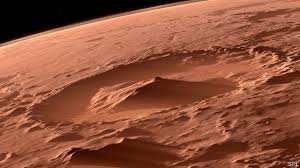On earth, most of the methane in the atmosphere has been belched by living organisms,
在地球上,大氣中的大部分甲烷都是由活著的生物體噴出的,
so finding the gas on Mars would be happy news for seekers after extraterrestrial life.
所以對(duì)探求者們來說,在火星上發(fā)現(xiàn)氣體是僅次于發(fā)現(xiàn)地外生命的好消息。
Sadly, news announced on December 12th, at the annual meeting of the American Geophysical Union (AGU), in Washington, DC, was anything but happy.
不幸的是,12月12日在華盛頓特區(qū)舉行的美國(guó)地球物理學(xué)會(huì)(AGU)年度會(huì)議上宣布的消息卻讓人開心不起來。
Preliminary results from ExoMars Trace Gas Orbiter, a European craft that has been circling Mars for the past two years,
歐洲的ExoMars微量氣體探測(cè)軌道飛行器在過去兩年中一直圍繞火星盤旋,
give a thumbs-down to the idea that there is methane in its atmosphere.
該飛船發(fā)回的初步結(jié)果與火星大氣中有甲烷的說法相悖。
Previous observations, from orbit and by telescopes on Earth, suggested Mars might sport traces of the gas.
從軌道發(fā)回的以及從地球望遠(yuǎn)鏡中觀察到的早期觀察結(jié)果表明火星上或許有氣體存在的痕跡。
These were backed up by data from Curiosity, an American Mars rover.
這些都得到了美國(guó)火星探測(cè)車好奇號(hào)的數(shù)據(jù)支撐。
In its six years crawling around a crater called Gale Curiosity has both detected methane
在六年的時(shí)間里,它一直圍繞著蓋爾環(huán)形山爬行,好奇號(hào)既探測(cè)到了甲烷
and recorded seasonal ups and downs of the stuff that cycle from a modest 0.25 parts per billion during the winter to 0.65ppbn in the summer, with spikes up to 7.0ppbn.
也記錄下了這種物質(zhì)季節(jié)性的波動(dòng),它穩(wěn)定地維持在冬季的幾十億分之0.25到夏季的幾十億分之0.65之間,有時(shí)會(huì)攀升至幾十億分之7。
That cyclical pattern has intrigued researchers back on Earth. Broadly speaking, there are two possible sources for Martian methane.
那種循環(huán)模式引起了地球上研究人員的興趣。一般來說,火星甲烷有兩種可能的來源。

One is outer space, whence carbon-rich molecules, some of which are likely to break down into methane, arrive constantly on meteors of various sizes.
一種是太空,那里有富含碳的分子,其中一些可能分解成甲烷,抵達(dá)大小各異的流星上。
The other is from under the planet's surface.
另一種是來自行星表面之下。
Methane from both sources will mix eventually into the atmosphere.
兩種來源的甲烷最終將混入大氣中。
But if the gas is coming from underground, it will be more concentrated near its source, and might well appear on a seasonal basis.
但是如果氣體來自于地下,那么它將更加集中于起源頭附近,并且有可能表現(xiàn)出季節(jié)性。
The process could be a geological or geochemical one that is encouraged by the relative warmth of summer. That would be interesting.
這一過程可以是地質(zhì)性或地球化學(xué)性的,并受到了夏季相對(duì)溫暖氣候的鼓動(dòng)。這很有趣。
Or it could be biological, with methane-generating bugs waking up during the summer months.
或者它可以是生物學(xué)過程,產(chǎn)生甲烷的蟲子在夏季的幾個(gè)月中醒來。
That would be headline-grabbing. For either to be the explanation of the seasonality observed by Curiosity,
這將會(huì)成為新聞焦點(diǎn)。不論好奇號(hào)觀測(cè)到的季節(jié)性解釋是哪一種,
the rover would have to have had the luck to land in an area of such methane seeps. But such lucky breaks do happen.
探測(cè)車將有幸著陸在這片甲烷滲出的區(qū)域。但是這種幸運(yùn)的事確實(shí)發(fā)生了。
譯文由可可原創(chuàng),僅供學(xué)習(xí)交流使用,未經(jīng)許可請(qǐng)勿轉(zhuǎn)載。












